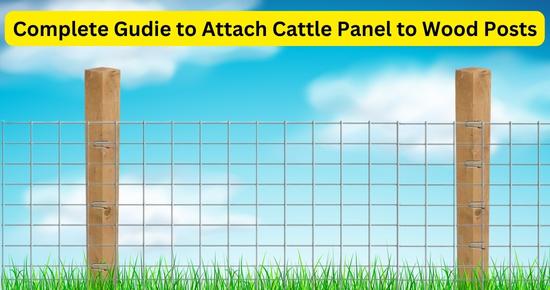To attach cattle panels to wood posts, most tools get attached to wood posts by drilling nails. A cattle panel to wood post connector, fence wire clamps, cat’s claw fasteners, pipe clamps & several other tools can be used to attach cattle panels to wood posts. They have an opening that catches cattle panel wire while screws hook them to wood posts.
A screwdriver drill with the appropriate drill bit is required for driving screws into wood, depending on the screw’s shape & size. Such as for a round screw with a + shape cut on the head, you’ll need a PZ drill bit. While for hex head screws, you’ll need a hex head driver bit. Fence staples can also be used for attachment; however, they just need a hammer for installation.
Follow the step-by-step guide to attach cattle panels to wood posts,:
- Start from the corner post & vertically align the cattle panel.
- Make sure the cattle panel is level vertically & horizontally. For this purpose, you can use a level tool.
- Keep the cattle panel touching the ground to keep animals from escaping.
Then, use any of the following tools to attach the cattle panel to the wood posts:
5 best tools to attach cattle panels to wood posts:
- Fence wire clamps
- Cats claw fasteners
- Cattle panel connectors for wood posts
- Pipe/conduit clamps
- Barbed fence staples(less recommended)
Tips: Any cattle panel to wood posts attachment tool that gets mounted by drilling screws can also be removed using a reverse function drill(that can rotate anticlockwise). Hence, most of these tools are reusable.
Below, we’ve discussed all tools & their installation methods that can be used to attach cattle panels to wood posts in detail.
Tool 1: Cattle panel connectors for wood posts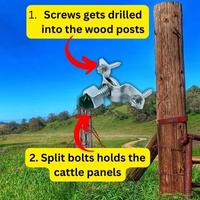
Tools required:
- Cattle panel to wood post connectors
- Screwdriver drill with hex screwdriver bit
Although cattle panel connectors are a little expensive, 3-4 $ per piece, they are specially designed to securely attach cattle panels to wood posts & join panels together, providing maximum tension against force. They are made of galvanized steel to prevent rusting. They can be removed to use later, which makes it ideal for long-term use.
It’s a simple bracket with two holes at both ends to drive screws into the wood posts. At the center, a split bolt is mounted that holds the wires of the cattle panel.
Cattle Panel connectors are removable & reusable; hence, they can serve you for a long time.
Tool 2: Cat’s claw fasteners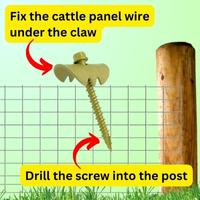
Tools Required:
- Cat claw fasteners
- Screwdriver drill with hex screwdriver bit
Cats claw fasteners are a great alternative to traditional fence staples & many other tools in terms of strength & cost. They are a more useful option than cattle panel to wood post connectors & several other tools in terms of price & strength. Cat’s claw fastener comes with a 14 gauge toothed claw with a hole at the center & a 2-inch hex screw. A pack of 100 costs around 40$.
Cat’s claw fastener can be used to attach any wire fence to wood posts & to keep the metal fence wires in place. Similarly, they can be removed with a reverse-functioning screw drill & can be reused, ensuring functionality for a longer time period.
To install, simply place the claw over the wire of the cattle panel. Then the screw is drilled through the hole in the claw into the wood posts using a screwdriver drill.
Tool 3: Fence wire clamps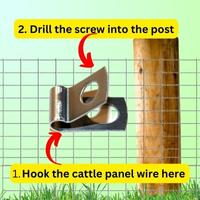
Tools Required:
- Fence wire clamps
- Screwdriver drill
- A screwdriver drill bit according to the selected screw
Fence wire clamps are R-shaped, small-sized mounting brackets with holes at both ends. The round hollow opening of this R shape clamp holds the fence wire while a screw is drilled from both holes into the wood posts.
Fence wire clamps are available in different sizes to hold fence wires of 2-16 gauges. A pack of 100 fence wire clamps usually costs around 15 $. Hence, it’s a great low-cost alternative for cattle panels to wood post connectors.
Tips: The screws come with fence wire clamps, are usually 1 inch long, and can be used only with fences that bear less weight, such as garden fences, or you just have to keep fence wire in place. That’s why, to attach heavy cattle panels for animal fences or large area fencing, you should use heavy-duty long screws.
Tool 4: Heavy-duty barbed fence staples
Fence staples are U-shaped hooks with sharp ends that get driven into the wood posts over the cattle panel wire. They are made of galvanized steel & cost less than 10 $ for a pack of hundred.
Choosing heavy-duty galvanized steel or glue-coated staples is better to prevent rusting. Barbed fence staples have sharp spikes & make a strong grip on the wood; hence, they are preferable for attaching heavy wire fences like cattle panels to wood posts.
You can easily drive them into wood posts using a hammer. Make sure to drive the fence staple completely into the wood. Use fence staples frequently at 6-12 inches intervals to securely attach cattle panels to wood posts.
Tool 5: Pipe straps(conduit clamp)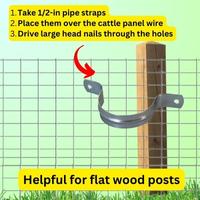
Pipe straps, or conduit clamps, are mainly designed to anchor pipes to other surfaces to prevent them from falling. However, they can be used as a cost-effective alternative tool to attach cattle panels to wood posts. They usually have flat ends(part with holes); hence are ideal for flat surface wood posts.
Pipe straps are available in polyethylene(plastic) & steel, but we’ve to use those made of steel. They are available for ½-4 inch pipe sizes. However, the cattle panel wires are quite thin compared to a pipe. So you should use ½ inch pipe straps. A pack of 100 1/2 inch pipe clamps costs around 20$.
You’ll also need wood screws with heads larger than the holes on the pipe clamp & screwdriver drill to drive them into wood posts.
Attaching cattle panels to metal posts – DIY Tools & Tips
Whether you are installing a cattle panel fence entirely with T-posts or you’ve incorporated them between wood posts. You can use several tools DIY tools, such as pieces of metal wire, fence clips, cattle panel connectors for T-posts, & zip ties to attach cattle panels to T-posts or metal posts.
The following tools can be used to attach cattle panels to metal posts:
- Metal wire costs the least & a 50 feet 10-16 gauge spool costs around 15-20$.
- Zip ties are average in terms of sturdiness. But you can use heavy-duty zip ties at fewer intervals to sturdily attach the cattle panels. A pack of heavy-duty zip ties costs around 10$.
- Post clips are also quite sturdy and available for all shapes of metal fence posts. They are easy to install & remove. A pack of 100 costs around 13-15$.
- T-post connectors for cattle panels are specially designed to fit over T-posts most easy to install and remove. They are reusable and hence serve for the longest time. A pack of 50 T-post connectors for cattle panels costs around 160$.
What to do if you have to connect cattle panels together?
While installing cattle panel fences, especially in a larger area or if you’ve installed fence posts not according to the length of cattle panels, you may have to attach cattle panels together at some points. There are several tools & methods to attach cattle panels together.
Method 1: Cut & twist the ends of cattle panels
If you don’t want to use/buy any tool, cut the ending vertical wire of a cattle panel & twist the horizontal wires to the vertical wire at the end of the other cattle panel.
Method 2: Using metal wire
The most cost-effective method to join cattle panels is using pieces of low-tensile hard metal wires. Metal wires are commonly available with DIY tools & in storerooms in homes. 12-16 metal wire is ideal for this purpose.
Steps to install:
- Cut 8-10-inch pieces of wire.
- Align the ends of cattle panels together.
- Wrap the wire multiple times around the cattle panel’s ending horizontal wire.
- At last, twist both ends of the wire together using a plier.
- For safety, bend the ends of the piece of wire.
- Similarly, attach the cattle panels at regular intervals of 1-2 feet using a wire.
Method 3: Using zip ties
If your fence has to withstand very low pressure, i.e., garden fence, you can also use heavy-duty UV-resistant zip ties. Although they are made of plastic, that’s not recommended for heavy wire fences such as cattle panel fences. However, high-quality zip ties can serve you for at least a year in short-area cattle panel fencing & if the fence has to bear minimum tension.
Method 4: Using hog panel connector
The hog panel connector hinge is a spiral metal wire that gets entangled with the ending vertical wire of the cattle panel from top to bottom. The installation is quite simple & requires no tool. Similarly, you can remove the spiral wire by rotating it anticlockwise & pulling it upward.
Alternatively, you can also use hose clamps or split bolts for attachment between two cattle panels.
Conclusion
As per my experience, all the tools, i.e., fence wire clamps, cats claw fasteners, cattle panels to wood post connectors, pipe clamps, and barbed fence staples, ideally work for attaching cattle panels to wood posts. The choice depends on your budget & the tools required for installation & its availability.
The sturdier & average costing tool is a cat’s claw fastener, while fence wire clamps are the most cost-effective.
For further assistance, ask us in the comments below.

